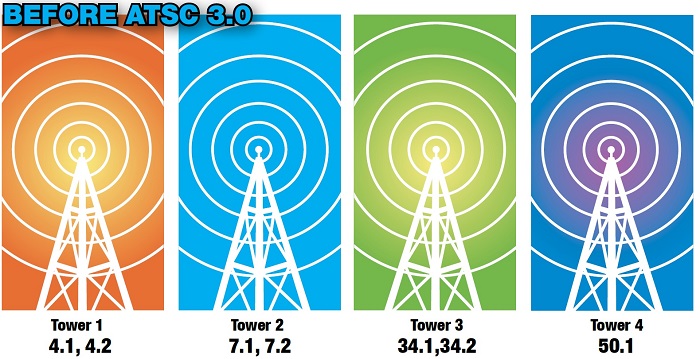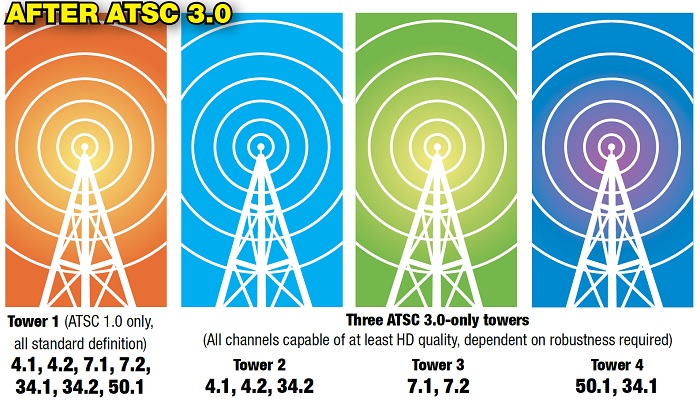
(#.1 are HD, #.2 are SD)
WASHINGTON— The amount of spectrum devoted to TV broadcasters is shrinking—from a peak of 486 MHz before 1983 to 294 MHz today. The incentive auction could easily reduce that to 210 MHz or less. How will broadcasters be able to deliver the same variety of programs and offer new services over the air with less spectrum? I don’t see any option but to make the move to ATSC 3.0, as difficult as that may be.
The move from NTSC to ATSC (1.0) allowed broadcasters to provide a far greater variety of programs in spite of the loss of 108 MHz of spectrum. This has led to a resurgence of interest in over-the-air reception, reversal of the decline in OTA viewers and increase in the number of companies selling TV antennas. However, the current ATSC standard and planning factors were designed around the outdoor antennas used for analog TV reception decades ago. It works OK with a good, fixed, indoor antenna in strong signal areas, but reception on portable or handheld devices is mixed.
A NEW STANDARD?
If broadcasters don’t make the move to ATSC 3.0 and the number of TV channels per market drops as expected after the incentive auction, the variety of TV programming available over the air will drop. Spectrum sharing will force stations to drop multicast channels. Unfortunately, as the number of program streams drops, so will interest in broadcast TV.
One reason mobile DTV (ATSC-MH) didn’t take off is that consumers didn’t see the need to buy (and in many cases carry) another device providing limited program/channel options. ATSC 3.0 will allow more efficient use of the spectrum, providing viewers with the same or greater number of program streams even with reductions in TV spectrum.
Furthermore, the robust transmission technology in ATSC 3.0 will make it easier for prospective viewers to see those program streams.
When I talk to broadcast engineers about ATSC 3.0, most are excited about its potential but being practical people, they question how we can transition from ATSC 1.0 to ATSC 3.0 without losing all the viewers we’ve finally gained back after the analog shutdown. The transition is the problem.
The professional video industry's #1 source for news, trends and product and tech information. Sign up below.
NO SECOND CHANNEL

With 3.0, 4.1 and 7.1 would be able to do UHD, as well as one of the two stations on tower 4, although at reduced quality (probably not sports). The dot-twos would be able to provide portable/mobile reception.
Unlike the ATSC 1.0 transition, broadcasters won’t be given a second channel. I wondered if technology such as layered division multiplexing, or LDM, which I covered in an earlier column, would work. The simple answer is no. While you could conceivably transmit an 8-VSB signal with a COFDM signal using LDM, a new receiver would be required. LDM requires the most robust signal to be the lower layer and the receiver has to cancel that in order to receive the upper layer signal.
It might be possible to transmit a very low-power and a very robust ATSC 3.0 signal that could still be received, but not interfere with surrounding market ATSC signals. The problem with this approach is that the ATSC 3.0 bit-rate would be very limited and, due to real-world propagation characteristics, it would be difficult to control interference. No one would buy ATSC 3.0 receivers to get low-resolution programs. That leaves only one option.
Broadcasters in each market will have to share their bandwidth to make an ATSC 3.0 transition possible. Before looking at the complications, here are some scenarios I think could work.
The simplest one involves two commonly owned stations. The programming from both stations would be transmitted in ATSC 1.0 on one station and ATSC 3.0 on the other. Due to the improved efficiency of ATSC 3.0, both stations should be able to provide all their program streams at today’s quality on the ATSC 3.0 channel and likely gain some robustness (improved service) on lower bit-rate streams. Combining both stations on the ATSC 1.0 channel will result in loss of quality and perhaps some program streams. This approach will work for some stations, but not most.
A more complicated scenario has multiple stations in a market act as ATSC 1.0 “lighthouse” stations, carrying the main program streams at reduced resolution from many stations. This allows for more ATSC 3.0 stations, perhaps a 4:1 ratio rather than the simple 2:1 ratio in the simple scenario, and more bandwidth.
More bandwidth would allow some stations to transmit UHD and HDR content, providing an incentive for people to buy ATSC 3.0 receivers, as well as an incentive for manufacturers to promote them.
One benefit of this approach is that some smaller stations may not have the resources to transition to ATSC 3.0, but by sharing their ATSC 1.0 bandwidth with other stations, they will have the opportunity to broadcast an ATSC 3.0 signal over the larger station’s facilities. Viewers switching to ATSC 3.0 won’t lose programming, potentially reducing the requirement for dual-standard tuners in future DTV receivers.
NOW, THE COMPLICATIONS...
Of course, there are complications. Multi-station channel-sharing raises legal questions. Although the FCC is allowing channel-sharing as part of the incentive auction spectrum reclamation, current station ID rules still require use of the transmitting station’s ID. TV network and program supplier agreements typically limit rebroadcast/simulcast of programming in a market on different platforms.
Broadcasters may want to make the transition and do it as painlessly as possible, but that will require a commitment to over-the-air broadcasting not only from the broadcaster, but from their affiliated network and content providers. Considering the duration of most network and program agreements, the transition channel-sharing issues need to be dealt with now.
A key technical issue is how well today’s TV receivers will handle multiple major channel numbers being transmitted over the same channel. Stations sharing a channel will not want to lose their channel-branding; the same issues will apply to new ATSC 3.0 receivers. Another issue involves interference to remaining ATSC 1.0 stations, which could preclude the buildout of market-wide ATSC 3.0 single-frequency networks, which will be key to maximizing ATSC 3.0 bandwidth and population served.
The ATSC “lighthouse” stations will have to simulcast at least the main programs from other stations in the markets for many years. I’ve heard estimates of around seven years.
Operational issues involve management of shared bandwidth, upkeep of older ATSC transmitter facilities, educating the public on the benefits of buying that new ATSC 3.0 TV set or TV-equipped tablet and replacing older ATSC 1.0 TVs.
I’m sure many readers will uncover more complications, but I hope some will come up with solutions I may have missed. The transition won’t be easy, but without it I question the future free OTA TV.
Comments are welcome! E-mail me atdlung@transmitter.com.

Doug Lung is one of America's foremost authorities on broadcast RF technology. As vice president of Broadcast Technology for NBCUniversal Local, H. Douglas Lung leads NBC and Telemundo-owned stations’ RF and transmission affairs, including microwave, radars, satellite uplinks, and FCC technical filings. Beginning his career in 1976 at KSCI in Los Angeles, Lung has nearly 50 years of experience in broadcast television engineering. Beginning in 1985, he led the engineering department for what was to become the Telemundo network and station group, assisting in the design, construction and installation of the company’s broadcast and cable facilities. Other projects include work on the launch of Hawaii’s first UHF TV station, the rollout and testing of the ATSC mobile-handheld standard, and software development related to the incentive auction TV spectrum repack. A longtime columnist for TV Technology, Doug is also a regular contributor to IEEE Broadcast Technology. He is the recipient of the 2023 NAB Television Engineering Award. He also received a Tech Leadership Award from TV Tech publisher Future plc in 2021 and is a member of the IEEE Broadcast Technology Society and the Society of Broadcast Engineers.
